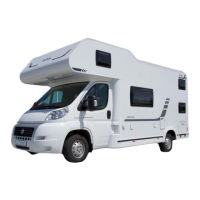02-7
The camper's brakes are deactivated
when you drive in reverse.
Brakes
A trailer carriage behaves differently from an indi-
vidual vehicle while braking. Therefore, it is advis-
able (especially for inexperienced drivers) to con-
duct several braking tests on a suitable surface.
The braking distance for a carriage is longer than
that of an individual vehicle. The load in the cara-
van also has a signicant inuence on the braking
distance.
Rules for braking
• Note the longer braking distance on wet roads.
• When driving down mountains or steep hills,
do not use a higher gear than when driving
uphill.
• During long drives over passes, permanently
overrunning the camper can cause the wheel
brakes to heat up considerably. If necessary,
you should allow enough time to enable them to
cool down again.
Driving in reverse
Your HOBBY camper has a braking system with
automatic reverse.
It enables you to drive back-
wards without applying the brakes, because the
overrun coupling does not differentiate between
overrunning or reversing the camper. When you
back up the camper, you must rst overcome a
slight residual brake torque in order to activate the
automatic reverse. You can then back up the cam-
per without any difculty. The next time the camper
moves forward, the normal braking facility is then
automatically applied again.
Due to the design of the brakes, there
may be increased wear in the brake
lining during the initial break-in phase.
After having driven 500 km, the basic
setting for the brakes must be
checked by an authorised specia-
list and adjusted if necessary (initial
inspection).
